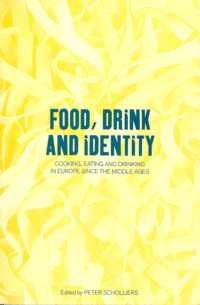

![]()
![]()

Scholliers tries valiantly to connect the chapters as a contribution to debates about identity, but the material proves resistant. Widespread uncertainty about how 'identity' should be understood, which Scholliers notes in his introduction, is never dispelled. While all authors use the term, most show neither interest in theories of identity and identification, nor any inclination to employ their empirical material to elucidate theoretical disputes. The contributors, it should be said, probably do little worse than most others in the theoretically weak arena of food studies, but nevertheless the integrating theme too frequently seems an artificial appendage.
Recent analyses of the concept of identity demonstrate the inherent complexity of its several constituent, and interwoven processes - a complexity intimated in Jenkins (1996) who articulates the internal/external dialectic of social identity and identification. With any simpler formulation, analysis reduces to invoking a few, general, abstract propositions about associations between food and identity: food preferences are personally meaningful; food practices are a means of distinguishing 'us' from 'them'; food consumption may express class, religious, ethnic or other group differences; foods may be promoted as symbolic of group, regional or national membership. These points can be exemplified endlessly by plausible instances, but illustrations of association suffice neither as an explanation, nor as a systematic contribution to evaluating theories, whether of food choice or of identity.
Considered individually, the essays are almost all of empirical interest, and they do illustrate aspects of identity formation and reproduction. One identification may supersede another, as when the fascist state attempted to sanctify the existing frugal practices of most of the population as the national Italian diet. Noble identity may persist despite radically reduced material circumstances. An item of food can cease to signify bourgeois identification if, as with the example of sugar in France, commercial agencies can persuade the working class that it is good for them. Subordinate groups may, in defence of collective identity, resist new and alien alternative foods that their oppressors seek to impose upon them.
Such processes are documented effectively, albeit in piecemeal fashion, by means of careful and detailed (mostly archival) research. Understandably, given restricted historical sources, the data available to each author are usually limited to one type: they concern the details of practice, from which identity has to be inferred; or they are representations in particular media, begging questions about reception and effects on audiences. An instructive exception was Willy Jansen's account from her ethnographic fieldwork in Algeria, my favourite essay in the collection. She managed to convey a sense of complexity and contradiction in the attitudes of native Algerians towards French products. Though French bread is widely used, Arab breads were valued more highly, being served exclusively on ceremonial occasions. More unexpectedly, and demonstrated in part through contemporary cartoons, Algerians are shown to be predisposed to throw away uneaten baguettes as a symbol both of their household having sufficient food and of their disdain for French culture. Jansen not only identifies symbolic aspects of local practices, but also argues effectively that they are underlain by the prevailing structure of political power, systems of economic exploitation and gender inequality. Multiple sources and an eye for the ambivalance and inconsistencies of everyday practice make for densely textured analysis.
Overall, the strength of this book lies in its historical detail. The general lesson to be learned is that the concept of identity is probably not the most promising, and certainly not a privileged, avenue for an integrated and theoretical analysis of the practices associated with food and drink.
Alan Warde
University of Manchester
